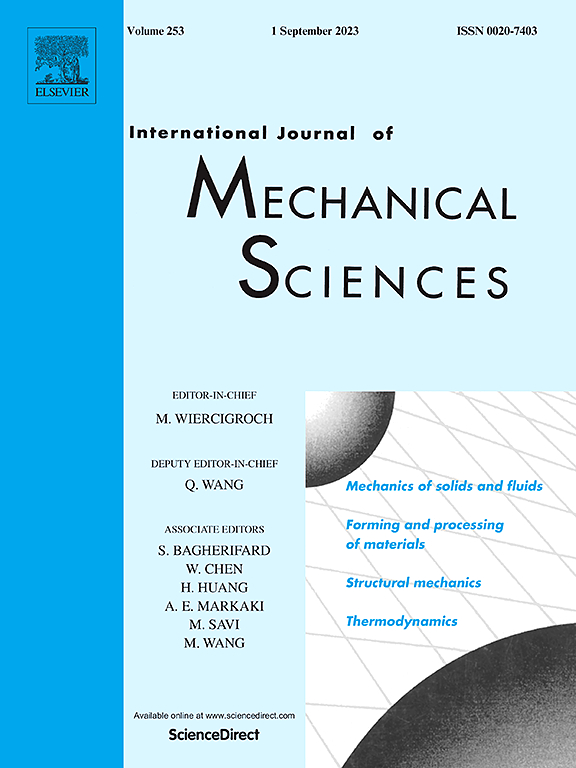Peridynamics beam plasticity theory: Yield surface for general cross-sectional geometry
IF 7.1
1区 工程技术
Q1 ENGINEERING, MECHANICAL
International Journal of Mechanical Sciences
Pub Date : 2025-04-15
DOI:10.1016/j.ijmecsci.2025.110249
引用次数: 0
Abstract
This paper presents a general way of deriving the yield surface for peridynamics (PD) Simo-Reissner beam plasticity theory from the three-dimensional (3D) von Mises yield surface and formulates a procedure to determine the plastic multiplier and elastoplastic tangent modulus. Beam plasticity problems are usually solved by employing the upper and lower bound theorems of plasticity and postulating interaction relations. However, it is well known that deriving exact expression for interaction equation is considerably difficult for a general beam cross-section and loading. To overcome this roadblock, the idea here is to express the yield surface in terms of cross-sectional coordinates by employing Simo-Reissner hypothesis on deformation field, expand the terms using Taylor series up to quadratic order, and analytically integrate over the cross-sectional area. This results in reduced form of the yield surface equation which involves beam cross-sectional properties such as area and moment of inertia. A return mapping algorithm is proposed to determine the plastic multiplier and the elastoplastic tangent modulus. This novel method does not require ad-hoc interaction relations derived from the upper and lower bound theorems and is applicable to any general beam cross-section. Numerical simulations include validation of displacement contour obtained from the proposed technique and the finite element method, and prediction of plastic deformation of cantilever beam, two-dimensional (2D) and 3D portal frames, 2D and 3D truss-frames, single unit octet lattice structure, 3×3×3 octet lattice structure, and compression-torsion lattice structures under quasi-static loading which demonstrate the potential of our approach.

周动力梁塑性理论:一般截面几何的屈服面
本文提出了从三维(3D)von Mises 屈服面推导周动力学(PD)Simo-Reissner 梁塑性理论屈服面的一般方法,并制定了确定塑性乘数和弹塑性切线模量的程序。梁塑性问题通常通过采用塑性上下界定理和假设相互作用关系来解决。然而,众所周知,对于一般梁的横截面和载荷,推导相互作用方程的精确表达相当困难。为了克服这一障碍,本文的想法是通过对变形场采用 Simo-Reissner 假设,用横截面坐标来表示屈服面,用泰勒级数展开项,直到二次阶,并对横截面积进行分析积分。这样就得到了屈服面方程的简化形式,其中涉及梁的横截面特性,如面积和惯性矩。提出了一种返回映射算法来确定塑性乘数和弹塑性切线模量。这种新方法不需要从上界和下界定理推导出的临时相互作用关系,适用于任何一般横梁截面。数值模拟包括验证从所提技术和有限元方法中获得的位移轮廓,以及预测悬臂梁、二维(2D)和三维门式框架、二维和三维桁架框架、单一单元八叉网格结构、3×3×3 八叉网格结构和压缩-扭转网格结构在准静态荷载下的塑性变形,这些都证明了我们方法的潜力。
本文章由计算机程序翻译,如有差异,请以英文原文为准。
求助全文
约1分钟内获得全文
求助全文
来源期刊

International Journal of Mechanical Sciences
工程技术-工程:机械
CiteScore
12.80
自引率
17.80%
发文量
769
审稿时长
19 days
期刊介绍:
The International Journal of Mechanical Sciences (IJMS) serves as a global platform for the publication and dissemination of original research that contributes to a deeper scientific understanding of the fundamental disciplines within mechanical, civil, and material engineering.
The primary focus of IJMS is to showcase innovative and ground-breaking work that utilizes analytical and computational modeling techniques, such as Finite Element Method (FEM), Boundary Element Method (BEM), and mesh-free methods, among others. These modeling methods are applied to diverse fields including rigid-body mechanics (e.g., dynamics, vibration, stability), structural mechanics, metal forming, advanced materials (e.g., metals, composites, cellular, smart) behavior and applications, impact mechanics, strain localization, and other nonlinear effects (e.g., large deflections, plasticity, fracture).
Additionally, IJMS covers the realms of fluid mechanics (both external and internal flows), tribology, thermodynamics, and materials processing. These subjects collectively form the core of the journal's content.
In summary, IJMS provides a prestigious platform for researchers to present their original contributions, shedding light on analytical and computational modeling methods in various areas of mechanical engineering, as well as exploring the behavior and application of advanced materials, fluid mechanics, thermodynamics, and materials processing.
 求助内容:
求助内容: 应助结果提醒方式:
应助结果提醒方式:


